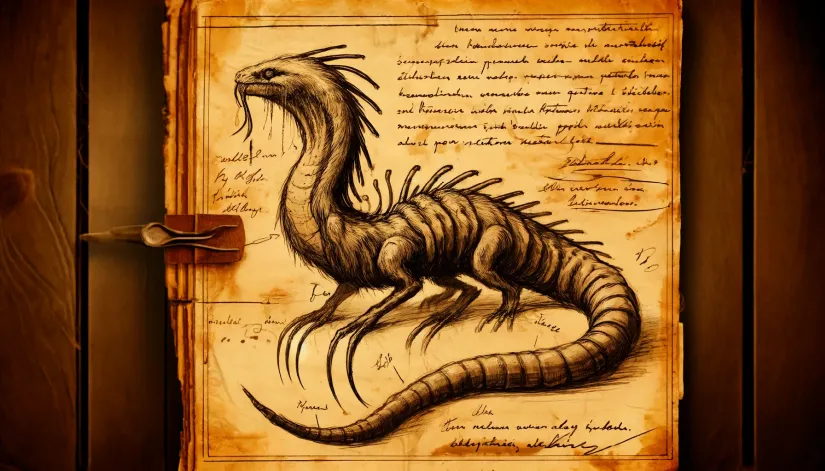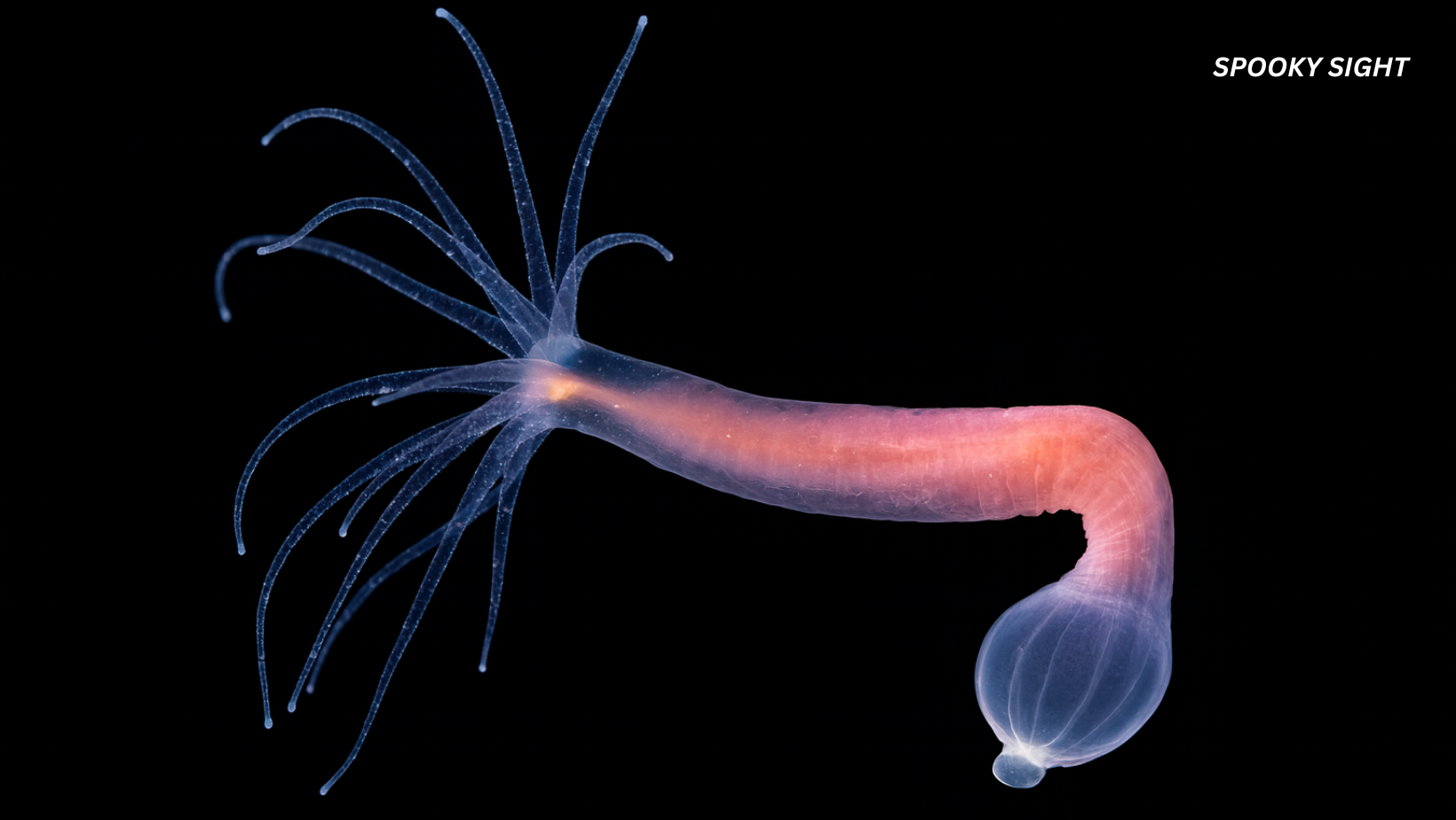Ever heard of the Tatzelwurm? Yeah, didn’t think so. This critter is one of Europe’s most bizarre cryptids—a downright odd creature with a snake-like body, big ol’ claws sprouting right from its limbs, and a cat-like head to top it off.
On top of that hideous look, it can also be extremely dangerous. According to local stories, it’s either venomous or capable of exhaling poisonous fumes.
First mentioned in the 16th century, sightings and stories about the creature have persisted through the years, with accounts from Germany, Austria, Switzerland, and even northern Italy.
As we explore the Tatzelwurm in more detail, we’ll look at its name’s etymology, appearance, alleged sightings, and various theories about what it could be—if it exists at all.
In this article:
Etymology
The name “Tatzelwurm” comes from the German language, combining two words: “Tatzel” (which translates to “paw” or “claw”) and “Wurm” (meaning “worm” or “serpent”).
What’s interesting is that, in older German, the term “Wurm” was not limited to the small invertebrates we associate with the word today. It could also refer to snake-like or mythical beasts. Much like how the word “dragon” is used in various cultures.
The name, therefore, reflects the creature’s most notable features—its clawed front limbs and serpent-like body. A worm with large claws.
The creature is also known by several different names, each reflecting local dialects and interpretations of the cryptid:
- Stollenwurm: Commonly used in Switzerland. This name can be broken down into “Stollen” (meaning “tunnel” or “hole”) and “Wurm” (worm). Translation? A “worm that lives in holes.” Makes sense, right? Given how it supposedly hides out in mountain caves and crevices.
- Arassas: In the French-speaking regions of the Alps—particularly in areas bordering Switzerland—the cryptid is sometimes called the “Arassas.”
- Bergstutzen: In Southern Germany—especially Bavaria—the Tatzelwurm can also be called Bergstutzen, translating loosely to “mountain stumpy.” Probably a nod to its stubby, squat appearance in some tales.
- Praatzelwurm: In some local Bavarian dialects, this European cryptid is also known as “Praatzelwurm.” However, it’s less common.
Why so much focus on the different names, you may ask. Simple. They clue us in on how people perceive this cryptid across various regions. Sure, the names switch up. Yet the descriptions are often consistent.
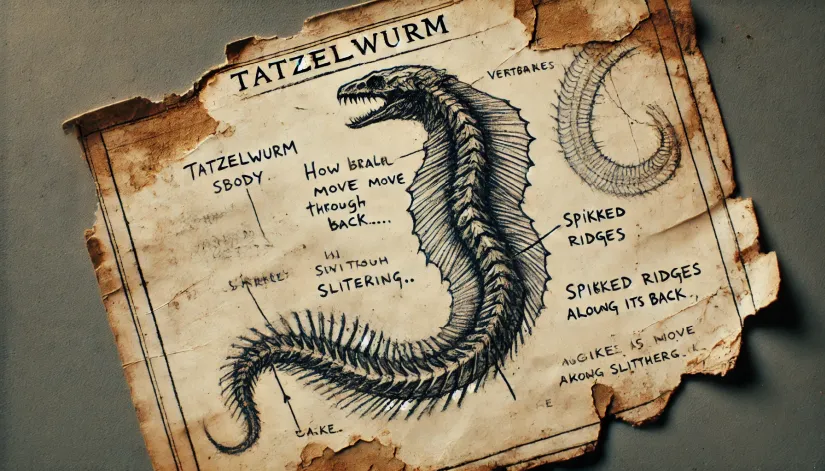
Physical Characteristics
Size and Body Structure
So, just how big is this thing? Well, Tatzelwurm’s size may vary significantly across different sightings. However, most accounts place it between 2 to 7 feet (0.6 to 2 meters) in length.
Its body is very similar to that of a snake (or lizard). But maybe a bit beefier. It’s got front limbs ending in a clawed paw, though there are conflicting accounts about whether it has hind legs, too.
SpookySight recommends:
- Mongolian Death Worm: Fact or Fiction? Inside the Gobi Desert’s Greatest Mystery
- Is the Yeti Real? Why We Think It May Be a Bear (But Can’t Be Sure)
- 16 Fascinating Facts About the Loch Ness Monster
For instance, some witnesses claim it is limbless, moving with a snake-like motion. In contrast, others describe it as having short, stubby limbs resembling a lizard.
The creature’s head is another distinctive feature. Most descriptions suggest it has a cat-like face, sharp teeth, and predatory eyes. However, some even say the head’s oversized compared to the body—almost cartoonish, like something out of a freaky animated film.
Unique Features
Beyond its basic structure, the Tatzelwurm is sometimes described as having spiked ridges running down its back and a forked tongue. Two very similar characteristics to mythical dragons or prehistoric reptiles.
These strange features make us think that the Tatzelwurm may be a relic from a bygone era, possibly a surviving species from the age of dinosaurs.
Another unusual aspect is its alleged venomous abilities. Several stories suggest that the creature’s bite is highly poisonous. Others claim the worm can breathe toxic fumes or exhale a noxious gas that incapacitates its prey.
And this poison and toxic fumes are potent enough to kill livestock and even humans.
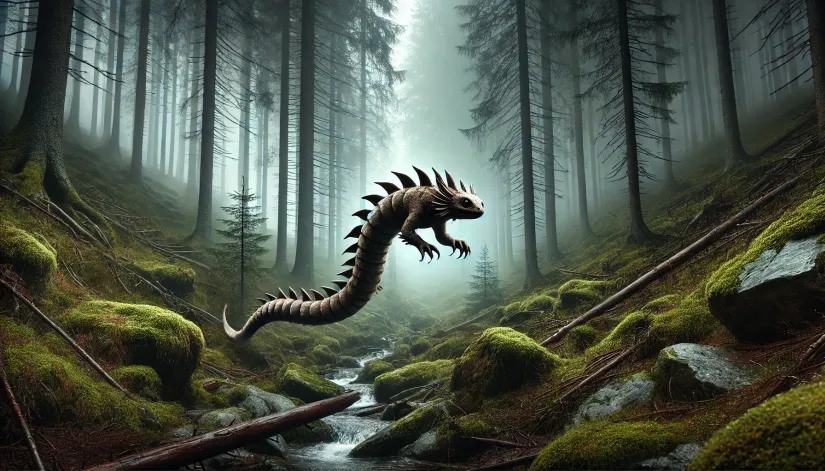
Movement and Agility
In terms of movement, well, that’s another bizarre aspect. Some witnesses claim the creature can leap or hop with surprising agility, much like a cat. However, the cryptid can slither like a snake, according to other presumable sightings.
Two movement methods that don’t really work together. At least it’s not like any other animal we know of.
Color and Camouflage
Most reports describe the Tatzelwurm as either brown or green, colors that allow it to blend in with its mountainous surroundings. These earth tones give it natural camouflage, helping it to hide among the rocks and vegetation of the Alps.
Related: Hillbilly Beast of Kentucky: A Bigfoot-like Cryptid with a Dark Twist?
Since it can easily camouflage in high vegetation and foliage, that may explain why sightings are rare and typically just for a few seconds.
Witnesses who have allegedly seen the cryptid generally describe it as emerging unexpectedly, blending so well into the background that it becomes nearly invisible until it moves.

Where Does the Tatzelwurm Allegedly Live?
The Tatzelwurm is primarily associated with the Alps, particularly in southern Germany (Bavaria), Switzerland, Austria, and occasionally extending into northern Italy. It prefers high altitudes, typically between 3,300 to 9,800 feet (about 1,000 to 3,000 meters), where human activity is limited.
It typically lives in mountain caves, rock crevices, and other hidden locations, particularly in areas difficult for people to access. These include the steep, rocky slopes of the Alps and forested valleys where the terrain is dense and challenging to navigate.
Related: The Canvey Island Monster: Facts, Sightings, and Theories
Interestingly, a lot of alleged sightings happen near water—lakes, streams, waterfalls. Maybe the worm needs a moist or humid environment to survive (like certain amphibians and reptiles)?
Sightings and Encounters
Over the years, tales of the Tatzelwurm have popped up all over the place. While most are anecdotal, they paint a pretty wild picture of a beast that’s spooked plenty of locals.
Here’s a comprehensive look at notable encounters throughout history:
First Reported Sightings (16th Century)
The first mentions of a snake-like monster inhabiting the remote regions of the Alps date back to the 16 century. However, keep in mind that we’re not talking about written records.
All these stories have been passed down through generations and are, most likely, either fabricated or grossly exaggerated.

Hans Fuchs’ Famous Encounter (1779)
One of the most well-known early Tatzelwurm sightings went down in 1779. A Swiss farmer, Hans Fuchs, allegedly spotted two creatures in the mountains.
Fuchs was hiking through a remote area of the Swiss Alps when he came face-to-face with two 5 to 7-foot-long worms with cat-like heads and large claws.
He was so terrified by what he saw that he reportedly suffered a fatal heart attack shortly after the encounter. Before his death, Fuchs managed to describe the creatures to his family, and this deathbed story became one of the most famous tales in Tatzelwurm lore.
The Half-Eaten Corpse (1828)
In 1828, a Swiss peasant reportedly found the half-eaten corpse of what was believed to be a Tatzelwurm.
According to the account, the creature’s body had been scavenged by crows. Because of that, the man could observe only part of the creature.
However, what he described matched previous accounts. The same snake-like body and clawed front limbs. The head was missing.
Unfortunately, the peasant hasn’t collected the body, so no physical evidence has been preserved from this discovery.
Raron, Switzerland, Report (1845)
Another notable 19th-century sighting happened in 1845 in the town of Raron, Switzerland.
A local man reported encountering a strange animal with a long body and limbs while traveling through a forested area near the Alps. However, the sighting was brief. Before the man could react, the odd creature slipped away between two big rocks.

The Five-Foot Skeleton Find (1924)
In 1924, two guys hiking in the Alps claim they found a five-foot-long skeleton in a remote spot. They claimed it looked like a giant lizard, but definitely not a snake since it had limbs.
However, the skeleton has since disappeared. No further evidence has been found to verify this discovery.
While some cryptozoologists consider this sighting an important lead in proving that the Tatzelwurm is real, we can also argue that the skeleton could have belonged to a known animal.
The Balkin Photograph Controversy (1934)
One of the most famous (and controversial) sightings happened in 1934 when a Bavarian photographer named Balkin claimed to have captured a photograph of the creature.
The photo showed a strange, stubby creature with a large head and what appeared to be clawed arms.
Naturally, the photo caused quite a stir among cryptozoologists and the general public. Though it was later debunked as a hoax—many thought Balkin staged it to drum up attention or boost local tourism.
Styria, Austria, Farmer’s Sighting (1954)
In 1954, a farmer from Styria, Austria, reported seeing a creature he identified as a Tatzelwurm. He said the cryptid was over five feet long, with a large, toothy mouth and a lizard-like body.
He claimed the beast appeared aggressive and quickly disappeared into a nearby crevice.
Bavarian Mayor’s Photo (1969)
In 1969, a Bavarian mayor took a photograph of what he claimed was a Tatzelwurm near a remote mountain village. The photograph showed a small, snake-like creature with a broad head and short limbs.
However, much like the Balkin photograph, this image was widely regarded as a hoax, likely staged to boost local tourism.
The Skeleton Donated to the Geneva Institute of Science (2000)
In 2000, a skeleton allegedly belonging to a Tatzelwurm was donated anonymously to the Geneva Institute of Science. The skeleton was accompanied by a letter from the law firm Gunterhaus in Germany. Yet, the benefactor’s name was never revealed.
The skeleton was described as likely reptilian. But with features matching the Tatzelwurm’s characteristics, including a long body and clawed limbs.
Despite the initial excitement surrounding the donation, no detailed studies or follow-up analyses have been released. As of now, the skeleton’s fate remains unknown. It was likely either discarded or kept in secrecy due to its inconclusive nature.
Sighting in Tresivio, Swiss-Italian Border (2009)
The most recent alleged Tatzelwurm sighting happened in 2009 near the Swiss-Italian border in Tresivio.
A research assistant claimed to have seen a two-legged, lizard-like creature running swiftly through the woods, likening its movement to that of a velociraptor.
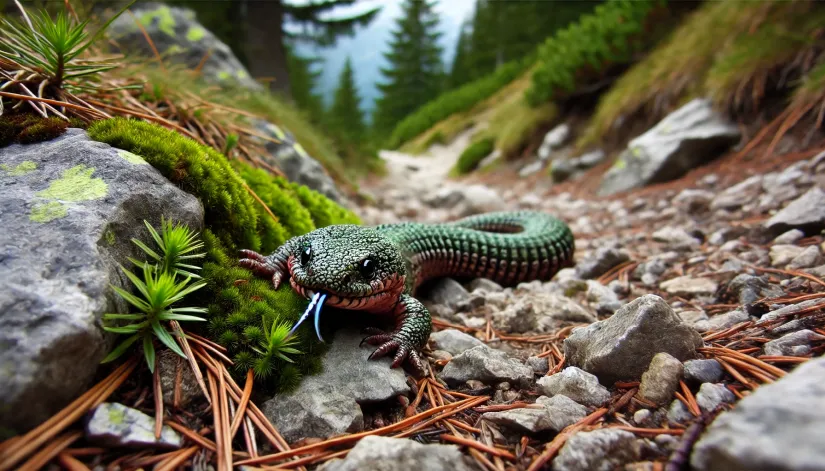
Scientific Theories and Possible Explanations
This strange European cryptid has prompted many cryptozoological theories over the years, each trying to explain the creature’s origins and characteristics.
These hypotheses range from the creature being an undiscovered species to more elaborate ideas of surviving prehistoric reptiles.
Salamander or Lizard
One of the more plausible theories within cryptozoology is that the Tatzelwurm could be a previously unknown species of salamander or lizard.
This theory suggests that the cryptid might be related to venomous reptiles, akin to the Gila Monster or European legless lizards, which share some physical traits described in eyewitness accounts.
Bernard Heuvelmans (often considered the father of cryptozoology) speculated that the Tatzelwurm might be an Alpine amphibian—possibly a large member of the Caudata order (salamanders) that managed to evade scientific classification due to its remote habitat in the Alps.
It’s a solid theory. Especially since there are cases of known animals being mistaken for cryptids. One such example is the Tiger Salamander. It’s bigger than your average salamander and likes to live underground.
Prehistoric Relic Theory
Another idea that has garnered attention is that the Tatzelwurm may be a surviving species of prehistoric reptile, specifically a small theropod dinosaur.
The unusual Tatzelwurm’s look—the long body, clawed limbs, and cat-like or reptilian head—resembles small, non-avian dinosaurs such as theropods.
These dinosaurs, like the velociraptor, had similar body structures, and sightings like the 2009 report of a Tatzelwurm running on two legs have led some to speculate that the creature could be a distant relative.
Sure, it’s a stretch, but it lines up with other cryptozoological hypotheses. One excellent example is the Mokele-mbembe in Africa.
If true, the Tatzelwurm could be a relict species—an animal thought to have gone extinct millions of years ago but has somehow survived in isolation.
Hibernation Theory
Here’s a more practical thought: maybe the Tatzelwurm hibernates during the brutal Alpine winters. That could explain why most sightings happen in spring and summer.
So, if the cryptid exists, it could be an amphibious or reptilian creature that hibernates underground during the colder months, emerging only when temperatures rise and food becomes available.
The idea is not that far-fetched since the Alps are full of rocky caves and crevices that would make cozy winter hideouts.
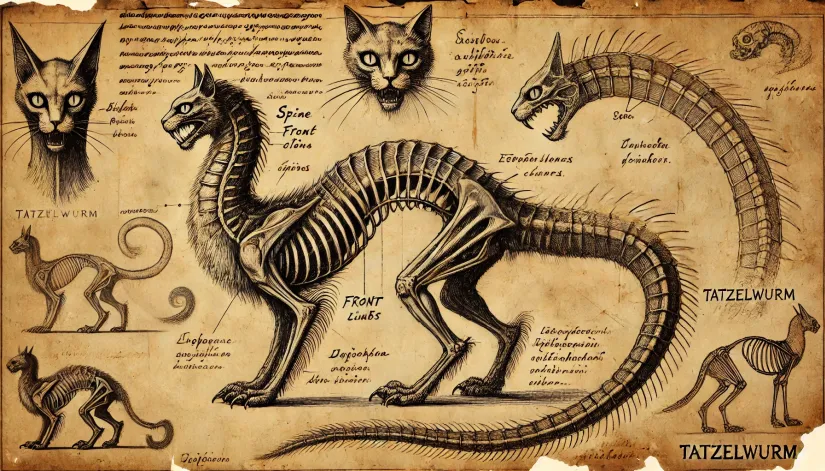
Hoaxes and Fabrications
Unfortunately, many cryptids (and the Tatzelwurm makes no exception) have been the subject of hoaxes and fabrications over the years. It’s a condemnable practice that has negatively impacted cryptozoology’s credibility as a science.
Perhaps the most famous example is the 1934 Surgeon’s Photograph. The image showed a creature’s long neck and head poking out of the water and was claimed to be the first undeniable evidence of the Loch Ness Monster.
However, it was revealed in the 1990s as a hoax, created using a toy submarine with a sculpted head and neck.
Another well-known case involves Bigfoot. In 1967, the Patterson-Gimlin film allegedly captured a large, bipedal creature walking through a forest in California. While the footage remains one of the most famous Bigfoot sightings, most now believe the footage was simply of a man in a gorilla costume.
Regarding Tatzelwurm, there have been at least two such hoaxes: the 1934 Balkin photograph and the 1969 Bavarian mayor’s photograph. Both have been dismissed as staged hoaxes.
The skeleton donated to the Geneva Institute of Science is another example of how false leads can hurt the credibility of cryptozoological research. While the skeleton fit the cryptid’s descriptions, no conclusive evidence was ever released.
This raised suspicions that it could have been another staged event aimed more at sensationalism than science.
Folklore Influence
Mass hysteria and the influence of local legends could also explain most of the alleged sightings. In rural, isolated regions, it’s not uncommon for folklore to shape perceptions of natural events or sightings of unusual animals.
Over time, repeated stories may have created a psychological expectation, where people are more likely to attribute strange shapes or movements to the cryptid rather than mundane animals.
In that way, the Tatzelwurm may be a product of the collective imagination, passed down through generations and evolving as new stories and sightings are added.
SpookySight Take
It’s pretty evident that the Tatzelwurm stands apart from other more fantastical cryptids.
Unlike the Impundulu (a lightning bird from South Africa), the Ninki Nanka (a dragon-like cryptid from West Africa), or the El Pombero (a mischievous trickster from South America), the Tatzelwurm’s characteristics feel much more… possible.
We think this European cryptid could actually be an unknown animal. The descriptions—featuring a snake-like body, clawed limbs, and reptilian features—align more closely with creatures we know exist. Like large lizards or even amphibians.
This places the Tatzelwurm in a category of cryptids where a scientific explanation is not just possible. But plausible. Its potential hibernation, venomous bite, and the remote habitat it inhabits could all point to an as-yet-undiscovered species. Perhaps a giant salamander or a distant reptilian relative.

